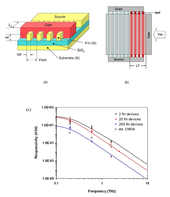Highlight
Silicon FinFET devices as terahertz detectors
Achievement/Results
Research done by IGERT graduates Dmitry Veksler (Physics), Bill Stillman (Electrical Engi-neering, and current IGERT trainee Chris Donais (Electrical Engineering) under Professor of Physics and Electrical Engineering Michael Shur’s supervision at Rensselaer Polytechnic Institute, Troy, NY has a potential to revolutionize terahertz electronics. They have developed plasma wave electronics devices, which use localized time-varying perturbations of charge carriers, so called plasma waves. This alternative to presently commercially available terahertz detectors, such as pyro-electrics and Schottky diodes, has a potential of achieving a much better performance. These new devices are compatible with silicon CMOS (Complementary metal-oxide-semiconductor) technology allowing for straightforward integration with large scale signal processor circuitry due to their inherent compatibility with mainstream semiconductor manufacturing. More recent work by Veksler, Stillman, and Donais used FinFET (field effect transistor) devices, where contrasting to conventional planar devices the conductive channel is formed in narrow raised “fins”, improve this situation dramatically. See Figure 1(a) and 1(b). Their research has shown responsivities of hundreds to in some cases thousands of volts per watt over a wide range of incident frequencies. See Figure 1©.
Address Goals
FinFETs accomplish the unrelenting reduction in device dimensions for microelectronic circuits. The unique properties of FinFETs allow for device dimensions down to below 20 nm with very low doping in the device channel and exemplary sub-threshold current/voltage ideality. These characteristics make the FinFET devices to be ideal prospects for detection of terahertz radiation. As well, the fin geometry itself has profound effects on the frequency range of detection. Our cross-discipline research efforts between the departments of Physics and Electrical Engineering here at RPI have enabled us to generate accurate predictive models of device response towards further understanding and optimization of the devices in this application. The IGERT program in Terahertz Science and Technology has played a major role; our efforts in this research are led by two recent IGERT graduates with the assistance of a current IGERT graduate student. In addition, we have cultivated the participation of undergraduate researchers in our work.






